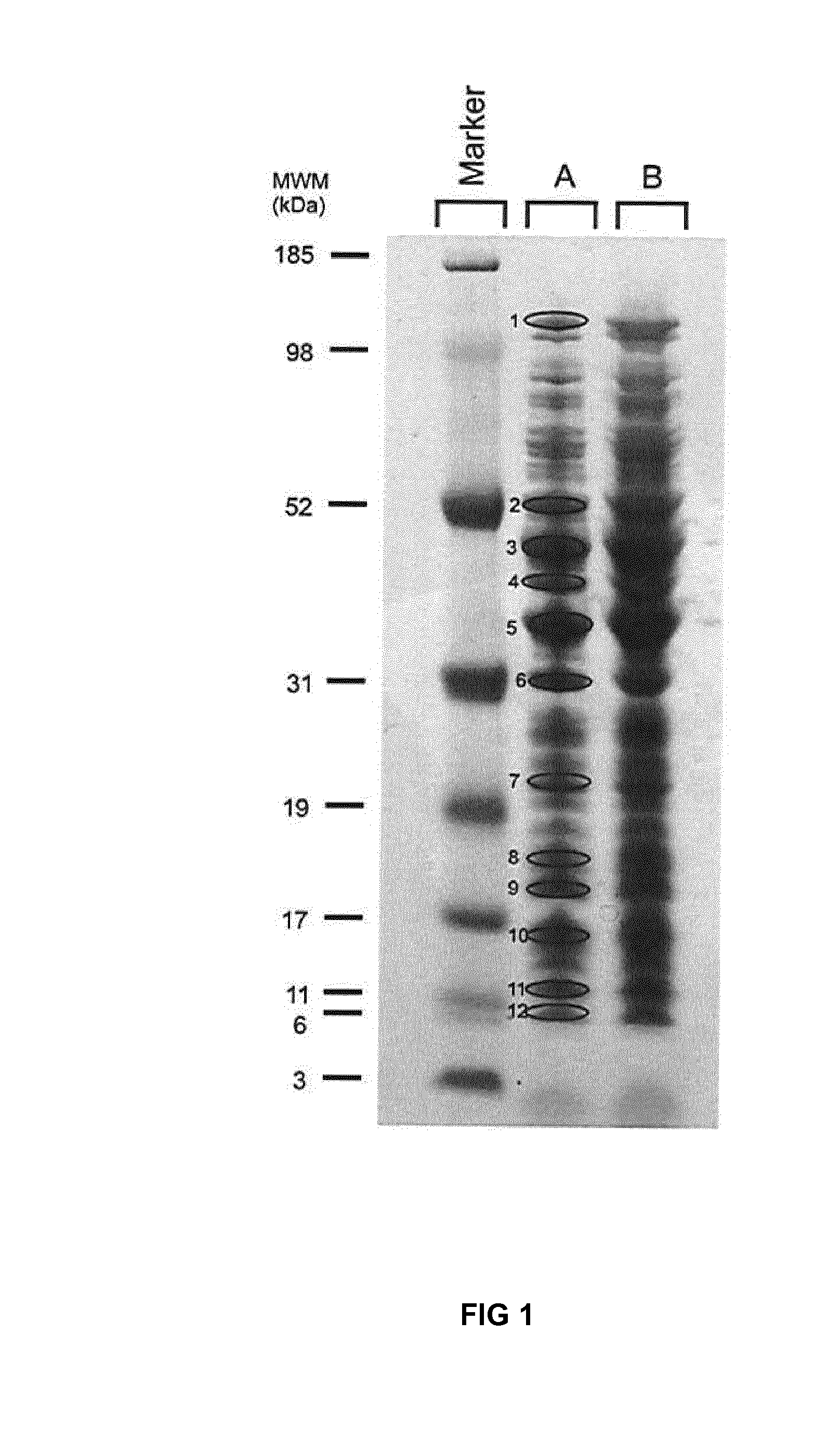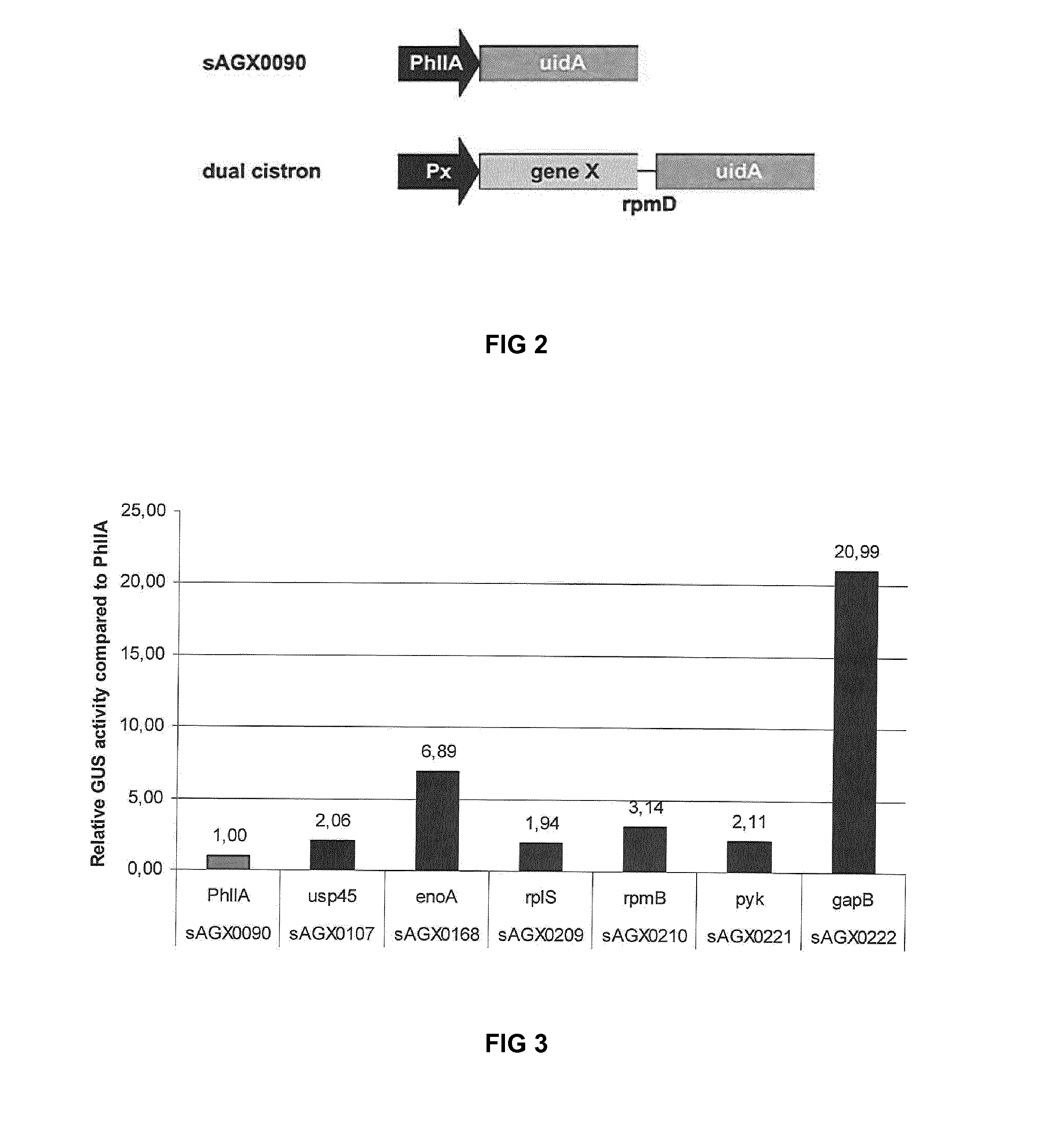Polycistronic expression system for bacteria
- Summary
- Abstract
- Description
- Claims
- Application Information
AI Technical Summary
Benefits of technology
Problems solved by technology
Method used
Image
Examples
example 1
Selection of Intergenic Regions from the Lactococcus lactis Genome
[0221]Cellular proteins of an end-log culture of Lactococcus lactis ssp. cremoris strain MG1363 were visualized onto a protein gel with Coomassie blue staining, as indicated in FIG. 1. Lanes A and B contained 29 μg and 58 μg MG1363 proteins, respectively. 12 defined proteins bands from lane A were isolated from the gel. Proteins were isolated and intergenic regions were identified by:[0222]1) Identification of abundantly expressed proteins in the fragments by partial peptide sequencing (MALDI-TOF / TOF) and database search using combined peptide masses and sequence information[0223]2) Identification, using the chromosome sequence of Lactococcus lactis ssp. cremoris strain MG1363 (Wegmann et al), of genes encoding the abundantly expressed proteins (1) that are present in an operon, but not as a “first gene”[0224]3) Identification of intergenic regions that precede these abundantly expressed genes
[0225]Table 3 lists thus ...
example 2
Selection of Sites for Bicistronic Expression
[0226]Table 4 lists target promoters identified in Example 1 as driving high level expression. These promoters can be used as target sites for polycistronic expression of exogenous genes.
TABLE 4BandGene as annotated in MG1363Name1DNA-directed RNA polymerase, beta′rpoCsubunit / 160 kD subunitDNA-directed RNA polymerase, betarpoBsubunit / 140 kD subunitnon-heme iron-binding ferritindpsA2pyruvate kinasepykglutamyl -tRNA synthetasesgltX3phosphopyruvate hydrataseenoglutamine synthetaseglnAglutamine synthetase repressorglnRdipeptidase PepVpepVF0F1-type ATP synthase beta subunitatpD(ATP synthase F1 beta subunit)F0F1-type ATP synthase alpha subunitatpA4multiple sugar-binding transport ATP-msmKbinding proteinacetoin dehydrogenase complex E1pdhAcomponent alpha subunit (acoA)cell division proteinftsAUDP-galactopyranose mutaseglf13-phosphoglycerate kinasepgkglyceraldehyde-3-phosphategapBdehydrogenaseacetate kinaseackA13-oxoacyl-(acyl-carrier-protein) syn...
example 3
Bicistronic Expression of Human Pro-Insulin
[0232]The usp45 secretion leader (SS) was fused to human pro-insulin (ins) to obtain secretion of pro-insulin (SS::ins). The [SS::ins] expression cassette was either integrated in the Lactococcus lactis MG1363 chromosome at the thyA locus and expressed directly from PthyA (sAGX0121) or was inserted, along with the rpmD intergenic region preceding SS::ins, as a second cistron downstream from usp45 (sAGX0121) or enoA (sAGX0164) (FIG. 4a). The insulin secretion capacity was quantified by ELISA to evaluate bicistronic expression of cargo compared to PthyA driven expression at the thyA locus.
[0233]Attempts to construct a PhIIA>>SS::Ins integration plasmid have failed.
[0234]Strains were inoculated from single colony into 2 ml GM17 supplemented with 200 μM thymidine when needed and grown for 16 hours at 30° C. For the quantification of pro-insulin secretion, these saturated overnight cultures were diluted 1 / 25 in 5 ml fresh GM17 medium and grown f...
PUM
| Property | Measurement | Unit |
|---|---|---|
| Composition | aaaaa | aaaaa |
| Therapeutic | aaaaa | aaaaa |
Abstract
Description
Claims
Application Information
 Login to View More
Login to View More - R&D
- Intellectual Property
- Life Sciences
- Materials
- Tech Scout
- Unparalleled Data Quality
- Higher Quality Content
- 60% Fewer Hallucinations
Browse by: Latest US Patents, China's latest patents, Technical Efficacy Thesaurus, Application Domain, Technology Topic, Popular Technical Reports.
© 2025 PatSnap. All rights reserved.Legal|Privacy policy|Modern Slavery Act Transparency Statement|Sitemap|About US| Contact US: help@patsnap.com



